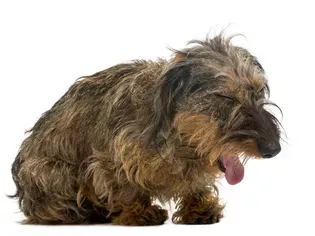Choking in Dogs
Updated on 04/26/24

Choking in Dogs: A Guide to Recognition, Prevention, and Treatment
Choking is a life-threatening emergency that can occur in dogs of any age or breed. It's essential for pet owners to be aware of the signs of choking, how to prevent it, and what to do in the event of an emergency. This comprehensive guide will provide you with the information you need to keep your furry friend safe and healthy.
Signs of Choking
The signs of choking in dogs can be subtle, so it's crucial to pay attention to your pet's behavior and physical symptoms. Here are some common indicators:
* Coughing: Persistent coughing is a sign that your dog may be trying to dislodge something stuck in its throat.
* Gagging: Gagging is a reflex that occurs when something obstructs the airway.
* Drooling: Excessive drooling can be a sign of distress and may indicate that your dog is unable to swallow properly.
* Pawing at the mouth: Dogs may paw at their mouths or rub their faces on the ground in an attempt to remove the obstruction.
* Difficulty breathing: Rapid, shallow breathing or gasping can be a sign that your dog's airway is partially or completely blocked.
* Cyanotic gums: Bluish or purple gums are an indication of severe oxygen deprivation. This is a medical emergency that requires immediate attention.
Prevention
The best way to prevent choking in dogs is to take precautions to minimize the risk. Here are some tips:
* Avoid giving your dog small, hard objects to chew on: Toys, bones, and food items like grapes or cherries can easily get stuck in your dog's throat.
* Supervise your dog while eating: Make sure your dog does not gobble down its food too quickly. Cut food into smaller pieces if necessary.
* Keep potential choking hazards out of reach: This includes household items like coins, hair ties, and rubber bands.
* Secure garbage cans and pet waste bags: Dogs may be tempted to eat discarded food or waste, which can contain objects that pose a choking risk.
* Vaccinate your dog against kennel cough: Kennel cough is a highly contagious respiratory infection that can cause coughing and gagging in dogs. Vaccination can help reduce the likelihood of your dog developing this condition.
Treatment
If you suspect your dog is choking, it's crucial to act quickly and calmly. Follow these steps:
* Stay calm: It's important to remain calm so that you can assess the situation and provide effective help.
* Check your dog's mouth: Gently open your dog's mouth and look for any visible objects that may be obstructing the airway. If you see something, carefully try to remove it using a pair of hemostats or tweezers.
* Perform the Heimlich maneuver: If you cannot remove the object visually, perform the Heimlich maneuver for dogs.
* Place your dog on its side: With your dog lying on its side, place your fist just behind the last rib cage and squeeze inward and upward with quick, firm thrusts.
* Continue until the object is dislodged or emergency help arrives: Repeat the Heimlich maneuver until the object is dislodged or a veterinarian can take over.
Emergency Care
If you are unable to dislodge the object using the Heimlich maneuver, seek emergency veterinary care immediately. The veterinarian may need to perform additional procedures, such as:
* Intubation: Inserting a tube into your dog's trachea to bypass the obstruction.
* Tracheotomy: Creating an opening in your dog's trachea to establish an airway.
* Surgery: In severe cases, surgery may be necessary to remove the obstruction.
Prognosis
The prognosis for dogs who have choked depends on the severity of the obstruction and how quickly treatment is received. With prompt intervention, most dogs can make a full recovery. However, if the airway is completely blocked for an extended period, there may be permanent damage to the lungs or brain.
Conclusion
Choking is a serious emergency that requires immediate attention. By understanding the signs of choking, taking preventive measures, and knowing how to perform the Heimlich maneuver, you can help keep your dog safe and healthy. If you suspect your dog is choking, do not hesitate to seek veterinary care.
Explore More Pets

Basic Training
Puppy and Baby Introductions

Working Dog Breeds
All About Search and Rescue Dogs

Dog Treatments
Puppy Vaginitis: Signs, Causes and Treatment

Dog Adoption
After More Than 1,200 Days in the Shelter, Coco Goes Home

Basic Training
How to Train Your Puppy to Go on Potty Pads

Hybrid Dog Breeds
The Difference Between a Mutt, Mixed Breed, or Designer Dog?

Dog Treatments
Nail Problems in Dogs

Puppies
7 Reasons Why Two Dogs Are Better Than One